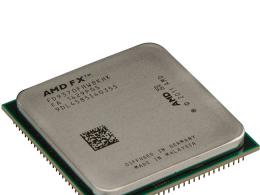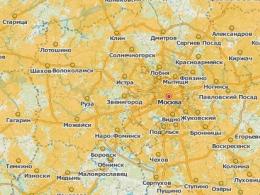What does the temperature coefficient of resistance show? The temperature coefficient of resistance is numerically equal to
|
Metal |
Specific resistance ρ at 20 ºС, Ohm*mm²/m |
Temperature coefficient of resistance α, ºС -1 |
|
Aluminum | ||
|
Iron (steel) | ||
|
Constantan | ||
|
Manganin | ||
The temperature coefficient of resistance α shows how much the resistance of a conductor of 1 ohm increases with an increase in temperature (heating of the conductor) by 1 ºС.
The conductor resistance at temperature t is calculated by the formula:
r t = r 20 + α* r 20 *(t - 20 ºС)
r t = r 20 *,
where r 20 is the resistance of the conductor at a temperature of 20 ºС, r t is the resistance of the conductor at temperature t.
Current Density
A current I = 10 A flows through a copper conductor with a cross-sectional area S = 4 mm². What is the current density?
Current density J = I/S = 10 A/4 mm² = 2.5 A/mm².
[A current I = 2.5 A flows through a cross-sectional area of 1 mm²; a current I = 10 A flows throughout the entire cross section S].
A switchgear bus of rectangular cross-section (20x80) mm² carries a current I = 1000 A. What is the current density in the bus?
Cross-sectional area of the tire S = 20x80 = 1600 mm². Current Density
J = I/S = 1000 A/1600 mm² = 0.625 A/mm².
The coil's wire has a circular cross-section with a diameter of 0.8 mm and allows a current density of 2.5 A/mm². What permissible current can be passed through the wire (heating should not exceed the permissible)?
Cross-sectional area of the wire S = π * d²/4 = 3/14*0.8²/4 ≈ 0.5 mm².
Allowable current I = J*S = 2.5 A/mm² * 0.5 mm² = 1.25 A.
Permissible current density for the transformer winding J = 2.5 A/mm². A current I = 4 A passes through the winding. What should be the cross-section (diameter) of the circular cross-section of the conductor so that the winding does not overheat?
Cross-sectional area S = I/J = (4 A) / (2.5 A/mm²) = 1.6 mm²
This section corresponds to a wire diameter of 1.42 mm.
An insulated copper wire with a cross-section of 4 mm² carries a maximum permissible current of 38 A (see table). What is the permissible current density? What are the permissible current densities for copper wires with cross-sections of 1, 10 and 16 mm²?
1). Allowable current density
J = I/S = 38 A / 4mm² = 9.5 A/mm².
2). For a cross section of 1 mm², the permissible current density (see table)
J = I/S = 16 A / 1 mm² = 16 A/mm².
3). For a cross section of 10 mm² permissible current density
J = 70 A / 10 mm² = 7.0 A/mm²
4). For a cross section of 16 mm² permissible current density
J = I/S = 85 A / 16 mm² = 5.3 A/mm².
The permissible current density decreases with increasing cross-section. Table valid for electrical wires with class B insulation.
Problems to solve independently
A current I = 4 A should flow through the transformer winding. What should be the cross-section of the winding wire with an allowable current density of J = 2.5 A/mm²? (S = 1.6 mm²)
A wire with a diameter of 0.3 mm carries a current of 100 mA. What is the current density? (J = 1.415 A/mm²)
Along the winding of an electromagnet made of insulated wire with a diameter
d = 2.26 mm (excluding insulation) a current of 10 A passes. What is the density
current? (J = 2.5 A/mm²).
4. The transformer winding allows a current density of 2.5 A/mm². The current in the winding is 15 A. What is the smallest cross-section and diameter that a round wire can have (excluding insulation)? (in mm²; 2.76 mm).
Per unit.
The temperature coefficient of resistance characterizes the dependence electrical resistance on temperature and is measured in kelvins to the minus first power (K −1).
The term is also often used "temperature coefficient of conductivity". It is equal to the inverse value of the resistance coefficient.
Temperature dependence of metal resistance alloys, gases, doped semiconductors And electrolytes is more complex.
Wikimedia Foundation. 2010.
- Kornyakt Palace
- The Private Life of Sherlock Holmes (film)
See what “Temperature coefficient of electrical resistance” is in other dictionaries:
temperature coefficient of electrical resistivity of conductor material- The ratio of the derivative of the electrical resistivity of a conductor material with respect to temperature to this resistance. [GOST 22265 76] Topics: conductor materials... Technical Translator's Guide
Temperature coefficient of electrical resistivity of conductor material- 29. Temperature coefficient of electrical resistivity of a conductor material The ratio of the derivative of the electrical resistivity of a conductor material with respect to temperature to this resistance Source: GOST 22265 76:… …
GOST 6651-2009: State system for ensuring the uniformity of measurements. Resistance thermal converters made of platinum, copper and nickel. General technical requirements and test methods- Terminology GOST 6651 2009: State system ensuring uniformity of measurements. Resistance thermal converters made of platinum, copper and nickel. Are common technical requirements and test methods original document: 3.18 thermal reaction time ... Dictionary-reference book of terms of normative and technical documentation
GOST R 8.625-2006: State system for ensuring the uniformity of measurements. Resistance thermometers made of platinum, copper and nickel. General technical requirements and test methods- Terminology GOST R 8.625 2006: State system for ensuring the uniformity of measurements. Resistance thermometers made of platinum, copper and nickel. General technical requirements and test methods original document: 3.18 thermal reaction time: Time ... Dictionary-reference book of terms of normative and technical documentation
Resistance thermometer- Symbolic graphic designation of a resistance thermometer Resistance thermometer electronic device, designed for measuring temperature and based on the dependence of electrical resistance ... Wikipedia
Resistance thermometer- a device for measuring temperature (See Temperature), the operating principle of which is based on a change in the electrical resistance of pure metals, alloys and semiconductors with temperature (on an increase in resistance R with increasing ... ...
Aluminum- (Aluminum) Alloys and production of aluminum, general characteristics Al Physical and chemical properties of aluminum, production and occurrence of Al in nature, application of aluminum Contents Contents Section 1. Name and history of the discovery. Section 2. General... ... Investor Encyclopedia
Thermal flow meter- Thermal flow meter is a flow meter in which the effect of heat transfer from a heated body by a moving medium is used to measure the flow rate of a liquid or gas. There are calorimetric and hot-wire flowmeters. Contents 1... ...Wikipedia
Aluminum- 13 Magnesium ← Aluminum → Silicon B Al ↓ Ga ... Wikipedia
Iron- (Latin Ferrum) Fe, chemical element VIII group periodic table Mendeleev; atomic number 26, atomic mass 55.847; shiny silvery white metal. The element in nature consists of four stable isotopes: 54Fe (5.84%),... ... Great Soviet Encyclopedia
Temperature coefficient of resistance
As you may have noticed, the electrical resistivity values in the table from the previous article are given at a temperature of 20 ° Celsius. If you assumed that they could change with temperature changes, you were right.
The dependence of wire resistance on temperature other than standard (usually 20 degrees Celsius) can be expressed through the following formula:
Alpha constant (α) is known as the temperature coefficient of resistance, which is equal to the relative change in electrical resistance of the section electrical circuit or the resistivity of a substance when the temperature changes by one. Since all materials have a certain resistivity (at a temperature of 20 ° C), their resistance will change by a certain amountdepending on temperature changes. For pure metalstemperature coefficient resistance is positive number what does increasing them mean? resistance with increasing temperature. For items like carbon, silicon and germanium , this coefficient is a negative number,
which means reducing them resistance with increasing temperature. Some metal alloys temperature coefficient of resistance very close to zero, which means an extremely small change in their resistance when it changes temperature. The following table shows values temperature coefficients resistance several common types metals:
| Conductor | α, per degree Celsius |
| Nickel | 0,005866 |
| Iron | 0,005671 |
| Molybdenum | 0,004579 |
| Tungsten | 0,004403 |
| Aluminum | 0,004308 |
| Copper | 0,004041 |
| Silver | 0,003819 |
| Platinum | 0,003729 |
| Gold | 0,003715 |
| Zinc | 0,003847 |
| Steel (alloy) | 0,003 |
| Nichrome (alloy) | 0,00017 |
| Nichrome V (alloy) | 0,00013 |
| Manganin (alloy) | 0,000015 |
| Constantan (alloy) | 0,000074 |
Let's use the example below to see how temperature can affect the resistance of the wires and its overall functioning:

The total resistance of the wires of this circuit (wire 1 + wire 2) at a standard temperature of 20 °C is 30 ohms. Let's analyze the circuit using a table of voltages, currents and resistances:

At 20 °C we get 12.5 V across the load, and a total of 1.5 V (0.75 + 0.75) voltage drop across the wire resistance. If the temperature is raised to 35 ° C, then using the above formula we can easily calculate the change in resistance on each of the wires. For copper wires (α = 0.004041) this change will be:

By recalculating the table values, we can see what consequences the temperature change led to:

Comparing these tables, we can come to the conclusion that the voltage across the load decreased with increasing temperature (from 12.5 to 12.42 volts), and the voltage drop across the wires increased (from 0.75 to 0.79 volts). The changes may seem minor at first glance, but they can be significant for long power lines connecting power plants and substations, substations and consumers.
Temperature coefficient of resistance(TKS) is a value that characterizes the relative change in the resistance of the resistor when the temperature changes by 1°C. In practice, they use the average value of the temperature coefficient of resistance, which is determined in the operating temperature range either using a special TCR meter, or by measuring three resistance values (at a temperature of 20 ° C, extreme positive and extreme negative temperatures) and then calculating the TCR using the formula
where TCR is the temperature coefficient of resistance, 1/°C;
∆R– algebraic difference between the resistance measured at given positive or negative temperatures and the resistance measured at normal temperature;
R 1 – resistor resistance measured at normal temperature;
∆t– algebraic difference between a given positive or given negative temperature and normal temperature.
Self-noise
The intrinsic noise of resistors consists of thermal and current noise. The noise level is measured by the electromotive force (EMF) of the noise.
The occurrence of thermal noise is associated with the thermal movement of electrons in a resistive element.
In addition to thermal noise, the level of which is determined mainly by the temperature and resistance of the resistive element and does not depend on the flowing current, specific current noise arises in the resistive element when it is switched on under an electrical load, caused by fluctuations in the contact resistance between conductive particles, as well as cracks and inhomogeneities of the resistive element . These fluctuations are a consequence of changes in the contact area of individual conductive parts of the element structure, voltage redistribution at individual gaps between these particles, the emergence of new conducting chains in relatively large gaps under the influence of high electric field strength, etc.
In semiconductor materials, current noise can be caused by conductivity fluctuations associated with the processes of excitation and recombination of current carriers and other processes.
Current noise at a given resistance value and a certain voltage value largely depends on the material and design of the resistive element and is most typical for non-wire resistors. They are usually much larger than thermal noise. The frequency spectrum of current noise energy is also continuous, but unlike the thermal spectrum, it is characterized by a decrease in the intensity of high-frequency components.
The noise level is determined by the ratio of the effective value of the alternating component of the noise voltage to the applied constant voltage and expressed in microvolts per volt
The higher the temperature and voltage, the higher the self-noise level of resistors. Noise limits the sensitivity of circuits and interferes with the reproduction of the desired signal.
The value of EMF noise for non-wire resistors ranges from fractions of units of μV/V, and for certain types up to tens of μV/V.
Conductor resistance (R) (resistivity) () depends on temperature. This dependence for minor changes in temperature () is presented as a function:
where is the resistivity of the conductor at a temperature of 0 o C; — temperature coefficient of resistance.
DEFINITION
Temperature coefficient of electrical resistance() is a physical quantity equal to the relative increment (R) of a circuit section (or resistivity of the medium ()), which occurs when the conductor is heated by 1 o C. Mathematically, the definition of the temperature coefficient of resistance can be represented as:
![]()
The value characterizes the relationship between electrical resistance and temperature.
At temperatures within the range, for most metals the coefficient under consideration remains constant. For pure metals, the temperature coefficient of resistance is often taken to be
Sometimes they talk about the average temperature coefficient of resistance, defining it as:
![]()
where is the average value of the temperature coefficient in a given temperature range ().
Temperature coefficient of resistance for different substances
Most metals have a temperature coefficient of resistance greater than zero. This means that the resistance of metals increases with increasing temperature. This occurs as a result of electron scattering on the crystal lattice, which enhances thermal vibrations.
At temperatures close to absolute zero (-273 o C), the resistance of a large number of metals sharply drops to zero. Metals are said to go into a superconducting state.
Semiconductors that do not have impurities have a negative temperature coefficient of resistance. Their resistance decreases with increasing temperature. This occurs due to the fact that the number of electrons that move into the conduction band increases, which means that the number of holes per unit volume of the semiconductor increases.
Electrolyte solutions have . The resistance of electrolytes decreases with increasing temperature. This occurs because the increase in the number of free ions as a result of the dissociation of molecules exceeds the increase in the scattering of ions as a result of collisions with solvent molecules. It must be said that the temperature coefficient of resistance for electrolytes is a constant value only in a small temperature range.
Units
The basic SI unit for measuring the temperature coefficient of resistance is:
Examples of problem solving
EXAMPLE 1
| Exercise | An incandescent lamp with a tungsten spiral is connected to a network with voltage B, current A flows through it. What will be the temperature of the spiral if at a temperature o C it has a resistance Ohm? Temperature coefficient of resistance of tungsten |
| Solution | As a basis for solving the problem, we use the formula for the dependence of resistance on temperature of the form: where is the resistance of the tungsten filament at a temperature of 0 o C. Expressing from expression (1.1), we have: According to Ohm's law, for a section of the circuit we have:
Let's calculate
Let's write the equation connecting resistance and temperature: Let's carry out the calculations: |
| Answer | K |
EXAMPLE 2
| Exercise | At temperature, the resistance of the rheostat is equal to , the resistance of the ammeter is equal and it shows the current strength. The rheostat is made of iron wire, it is connected in series with the ammeter (Fig. 1). How much current will flow through the ammeter if the rheostat is heated to a temperature? Consider the temperature coefficient of resistance of iron to be equal to . |






